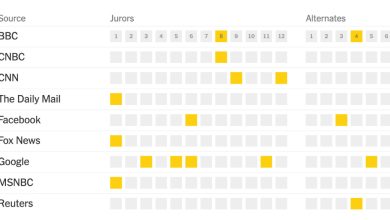Dave Smith, Whose Synthesizers Shaped Electronic Music, Dies at 72

Dave Smith, a groundbreaking synthesizer designer, died on May 31 in Detroit. He was 72.
The cause was complications of a heart attack, said his wife, Denise Smith. Mr. Smith, who lived in St. Helena, Calif., had been in Detroit to attend the Movement Festival of electronic music, which ran from May 28 to 30, and died in a hospital.
A statement from Mr. Smith’s company, Sequential, said, “He was on the road doing what he loved best in the company of family, friends and artists.”
Mr. Smith introduced the first polyphonic and programmable synthesizer, the Sequential Circuits Prophet-5, in 1978. It was used on 1980s hits by Michael Jackson, the Cars, Madonna, Peter Gabriel, Talking Heads, a-ha, Duran Duran, Genesis, the Cure and Daryl Hall & John Oates. Over the next decades, instruments designed by Mr. Smith were embraced by Radiohead, Arcade Fire, Dr. Dre, Flying Lotus, Nine Inch Nails and James Blake, among many others.
In the early 1980s, Mr. Smith collaborated with Ikutaro Kakehashi, the founder of the Roland instrument company, to create MIDI (Musical Instrument Digital Interface), a shared specification that allows computers and instruments from diverse manufacturers to connect and communicate, making for countless sonic possibilities.
Justin Vernon, who records as Bon Iver, wrote on Twitter, “Dave Smith made the best keyboards ever … that’s saying it lightly.”
Denise Smith said in an interview: “He loved the people who used his instruments. He was very curious about how they used his instruments, how they made them sound.”
David Joseph Smith was born in San Francisco on April 2, 1950, the son of Peter and Lucretia Papagni Smith. He played piano as a child and guitar and bass in rock bands, in high school and at the University of California, Berkeley, where he earned a degree in computer science and electrical engineering. One of his college projects was working on a program to compose music, printing out the scores on a plotter. After graduating, he worked on what was then a new technology — microprocessors, integrated circuits on a chip — at the aerospace company Lockheed, in the area of California that would become known as Silicon Valley.
He was intrigued by the synthesizer sounds on Wendy Carlos’s 1968 album, “Switched-On Bach,” he said in a 2014 interview with the Red Bull Music Academy. “It just had this life in it that was just amazing to hear.”
In 1972, his interests in music and electronics converged when he bought a Minimoog, an early Moog synthesizer. He then built his own sequencer, a device to store and play patterns of notes on the Minimoog. In 1974, he started a company to build sequencers, Sequential Circuits — at first as a nights-and-weekends project, then as a full-time job, eventually as a company with 180 employees.
Unlike a piano or organ, early synthesizers, like the Moog and ARP, could generate only one note at a time. Shaping a particular tone involved setting multiple knobs, switches or dials, and trying to reproduce that tone afterward meant writing down all the settings and hoping to get similar results the next time.
The Prophet-5, which Mr. Smith designed with John Bowen and introduced in 1978, conquered both shortcomings. Controlling synthesizer functions with microprocessors, it could play five notes at once, allowing harmonies. (The company also made a 10-note Prophet-10.) The Prophet also used microprocessors to store settings in memory, providing dependable yet personalized sounds, and it was portable enough to be used onstage.
Mr. Smith’s small company was swamped with orders; at times, the Prophet-5 had a two-year backlog.
But Mr. Smith’s innovations went much further. “Once you have a microprocessor in an instrument, you realize how easy it is to communicate digitally to another instrument with a microprocessor,” Mr. Smith explained in 2014. Other keyboard manufacturers started to incorporate microprocessors, but each company used a different, incompatible interface, a situation Mr. Smith said he considered “kind of dumb.”
In 1981, Mr. Smith and Chet Wood, a Sequential Circuits engineer, presented a paper at the Audio Engineering Society convention to propose “The ‘USI’, or Universal Synthesizer Interface.” The point, he recalled in a 2014 interview with Waveshaper Media, was “Here’s an interface. It doesn’t have to be this, but we all really need to get together and do something.” Otherwise, he said, “This market’s going nowhere.”
Four Japanese companies — Roland, Korg, Yamaha, and Kawai — were willing to cooperate with Sequential Circuits on a shared standard, and Mr. Smith and Mr. Kakehashi of Roland worked out the details of what would become MIDI. “If we had done MIDI the usual way, getting a standard made takes years and years and years,” Mr. Smith told Waveshaper. “You have committees and documents and da-da-da. We bypassed all of that by just basically doing it and then throwing it out there.”
In 2013, Mr. Smith told The St. Helena Star: “We made it low-cost so that it was easy for companies to integrate into their products. It was given away license free because we wanted everyone to use it.”
Sequential Circuits made the first MIDI synthesizer, the Prophet-600, in 1982, and MIDI was formally announced in 1983. Nearly four decades later, the MIDI 1.0 standard is still ubiquitous, and MIDI controllers, which specify the parameters of an electronic tone, are available in everything from keyboard, wind and string instruments to cellphone apps.
In 2013, 30 years after MIDI was introduced, Mr. Smith and Mr. Kakehashi shared a Technical Grammy Award.
Yamaha bought Sequential Circuits in 1987, but by then cheaper digital synthesizers had grown more popular than analog instruments like the Prophet-5, and in 1989 Yamaha shut the company down.
Mr. Smith married Denise White in 1989, and they settled in St. Helena, in Northern California. In addition to her, he is survived by their daughter, Haley; their son, Campbell; and four siblings.
Mr. Smith worked in synthesizer research for Yamaha and then for Korg, where he was among the designers of the Wavestation, which was used for hits by Depeche Mode and Genesis. In the 1990s, he turned to designing software synthesizers — programs creating sound directly from a computer. He was president of Seer Systems, which in 1997 introduced the first professional software synthesizer, the Windows program Reality.
But Mr. Smith decided he preferred using and designing hardware, and he returned to a hands-on experience making music. As analog synthesizers gained a new following in the 21st century, he founded Dave Smith Instruments in 2002. He collaborated with Roger Linn, the inventor of the LM-1 drum machine, on a new analog drum machine, the Tempest, and with another synthesizer inventor, Tom Oberheim, on the OB-6.
In 2018, after Yamaha returned the rights, he renamed his company Sequential, and in 2020, when Mr. Smith turned 70, the company introduced a revived, updated Prophet-5.
“Ultimately whatever I design is something that I want to be able to play when I’m done,” Mr. Smith told Waveshaper. “Otherwise, what’s the point?”




